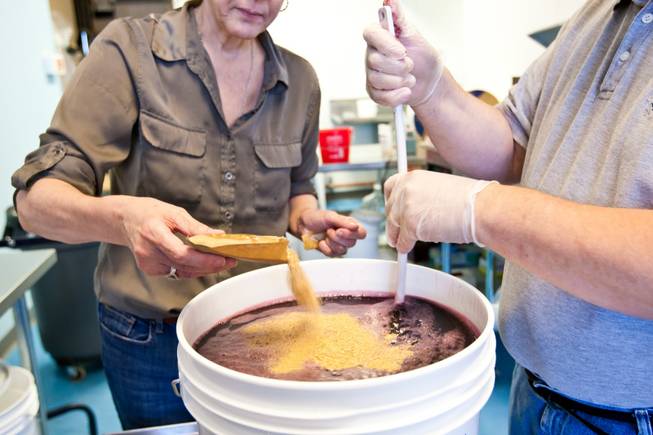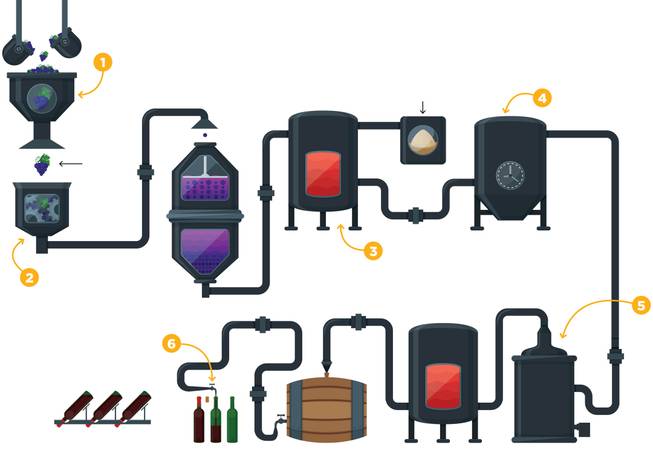
Mona Shield Payne
Hope Pasinski adds American Oak powder while her husband, Gene, stirs the must during winemaking class held at U Bottle It in Henderson Friday, May 3, 2013.
Monday, Oct. 26, 2015 | 2 a.m.
Every time you lift a glass of wine to your lips, you aren’t just having a drink. You are partaking in history.
The brilliant, fermented liquid is as old as civilization itself. The cultivation and fermentation of grapes dates to ancient Mesopotamia.
Through the years, however, thousands of varieties have been developed, which is why choosing a flavor or style can be a major undertaking.
Still, while wine is complex, it can be simplified for those of us who aren’t connoisseurs. A little understanding of what goes into different types of wines, and which foods to pair them with, will have you confidently ordering your next glass of vino.

Six steps to making wine
The process
1. Winemakers and experts agree: The better the grapes, the better the wine. While the wine making process affects the flavor of wine, the quality of the grapes determines the quality of the wine. Grape quality depends on weather, soil conditions and how the grapes are pruned during and between seasons. The riper the grapes are when picked, the sweeter the wine will be, so harvesters often wait until the last possible moment.
2. The grapes are put into a crusher, then a presser to squeeze out the juice. For red wine, entire grapes are used, including skins, seeds and sometimes stems. For white wine, only the grape juice is used during fermentation.
3. The liquid is put into large stainless steel tanks, and yeast is added to convert the sugar in the grape juice into alcohol. Winemakers regularly experiment with different types of yeast to try to improve their wine.
4. As the wine ferments, the sugar level drops and the alcohol level rises. Red wine must ferment between 86 and 95 degrees Fahrenheit for 10 days.It generally has an alcohol content of between 11 and 13 percent. White wine must ferment at 63 degrees Fahrenheit for three weeks. It generally has an alcohol content of between 11 and 11.5 percent.
5. The wine is stored for a few months before being run through pressure filters to remove unwanted particles before bottling.
6. It is crucial during the bottling process to prevent air from getting into the bottle as oxygen sours the wine. Bottles often are dark in color because light also can affect the flavor of wine. Once bottled, the wine will undergo minor organic changes as it ages.
Guide to white wines
The proper way to drink wine
1. Pour the wine into a glass. The larger the glass, the better, to release aroma and help the wine breathe.
2. Swirl the wine in the glass to check the color and consistency. Hold the glass by its stem so you don’t warm the wine with your hand.
3. Smell the wine. Some argue the aroma of a wine is more important than the taste.
4. Sip the wine. Yes, the wine is delicious, but don’t chug it like a mug of beer. Wine is meant to be savored.
5. Note the aftertaste. It is a major determinant of the wine’s quality.
White wine generally has a softer taste than red wine. White wine, particularly drier varieties, also is commonly used in cooking.
• Chardonnay. Chardonnay is the most popular of all white wines. It originated in Bourgogne, France. Chardonnays often have a velvety, citrus flavor. They sometimes are fermented in oak barrels, giving them a buttery tone. Pair with: chicken, fish, shellfish
• Pinot grigio. Pinot grigio is another extremely popular white wine. It is grown primarily in Italy, although many versions are made on the West Coast of the United States. Pinot grigios are very dry, with a crisp, acidic bite. Pair with: Thai food, spicy Chinese food
• Riesling. Originating in Germany, Riesling is a much lighter wine than chardonnay. Rieslings tend to taste different depending on where they were made, but most have a fresh apple aroma. Pair with: fish, chicken, pork
• Moscato. Named for the muscat family of grapes that create this wine, moscato typically is produced in Italy or Austria. Moscatos are fruity, with a distinct grapefruit aroma. Pair with: nothing. Moscato usually is enjoyed on its own.
• Sauvignon blanc. Sauvignon blanc originated in France with grapes that thrive in cooler climates. With one of the widest varieties of flavor, sauvignon blancs can have undertones of bell peppers, apples, pears or gooseberries. Pair with: chicken, salad
• Semillon. Also from France, semillon has a fig-like flavor. In fact, the berry flavors of semillons are so strong, the wine often is blended with sauvignon blanc to tone down the taste. Pair with: clams, mussels, pasta salad
Guide to red wines
Why is wine better with age?
Many wines made today are intended to be opened immediately and would go bad if cellared for a long period.
Wines with high tannin levels age best. Tannins are chemicals that come from grape skins and seeds. They give wine its bitter taste and make your mouth feel dry. As wine ages, the tannins form chains with each other in a process called polymerization. This softens the wine, making it feel and taste less harsh. A wine’s aroma also strengthens during aging as the tannins polymerize.
Red wines are made from dark-colored, often black, grapes. The color of red wine can range from intense violet, typical of young wines, to brick red for mature wines and brown for older wines.
• Merlot. The most popular wine by far, merlot is king of the vino kingdom. Its soft flavor and drinkability makes it the go-to wine for beginners. Merlots typically have black cherry, plum and herbal flavors, and are far less tannic than other dark red wines. Pair with: Italian or Spanish food, roasted vegetables
• Cabernet sauvignon, Another extremely popular red wine, cabernet sauvignon often is blended with merlot. Many varieties undergo an oak treatment. Young cabernet sauvignons have a strong flavor, but the wine mellows dramatically with age. Pair with: steak, beef, barbecue
• Shiraz. Also known as Syrah, Shiraz is common in California and Australia. The wine often has black currant flavors with black pepper overtones. It is known as one of the spiciest wines for its strong flavor. Pair with: beef, wild game, stew
• Pinot noir. One of the most noble red wines, pinot noir rarely is blended with other types of grapes. It has a surprisingly smooth taste and is delicate with much softer tannins than cabernet sauvignon. Cherry, plum and strawberry flavors are common. Pair with: grilled salmon, lamb, sushi
• Malbec. Malbec originates from the Bordeaux region of France. Malbec is a varietal wine, meaning its flavor varies greatly depending on where it is grown, such as Chile, Australia or cooler parts of California. Malbecs often are blended with other wines such as cabernet sauvignons. Pair with: Mexican, Indian or Cajun food
Hybrid
• Zinfandel. Often referred to as the world’s most versatile wine grape, zinfandel grapes make a number of wines, including rosés, white zinfandels and heavy red wines. White zinfandel, for instance, is a pink wine in which grape skins and stems are removed halfway through the fermentation process. Pair with: spaghetti, pizza

Join the Discussion:
Check this out for a full explanation of our conversion to the LiveFyre commenting system and instructions on how to sign up for an account.
Full comments policy